Economics Assignment: Analysis of Economic Indicators for Australia and New Zealand
VerifiedAdded on 2023/06/08
|13
|4241
|413
AI Summary
This report analyzes the trend movement in different economic indicators for Australia and New Zealand from 1995 to 2015. It covers real GDP growth, inflation, unemployment rate, cash rate, and official cash rate. The report also provides an economic outlook for both countries.
Contribute Materials
Your contribution can guide someone’s learning journey. Share your
documents today.
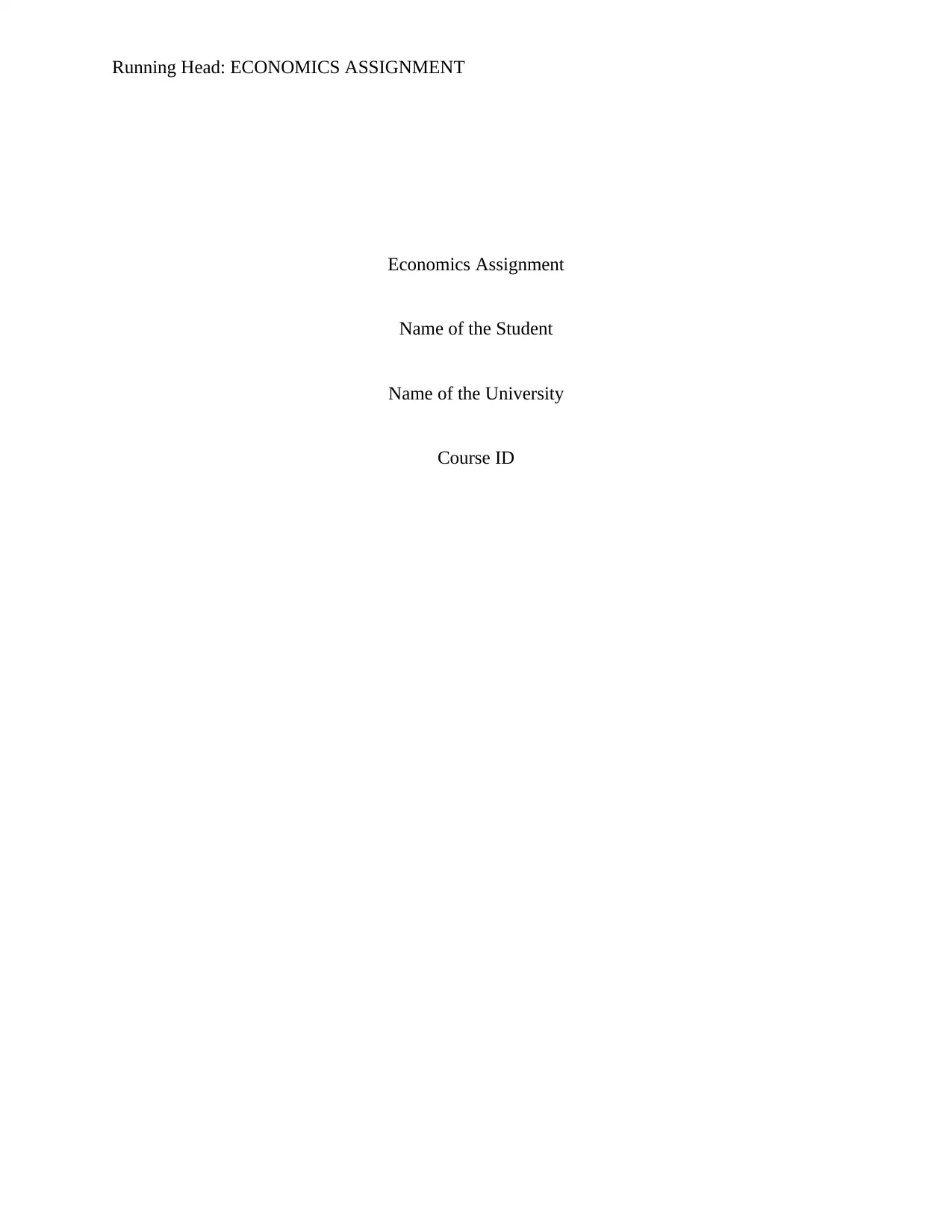
Running Head: ECONOMICS ASSIGNMENT
Economics Assignment
Name of the Student
Name of the University
Course ID
Economics Assignment
Name of the Student
Name of the University
Course ID
Secure Best Marks with AI Grader
Need help grading? Try our AI Grader for instant feedback on your assignments.
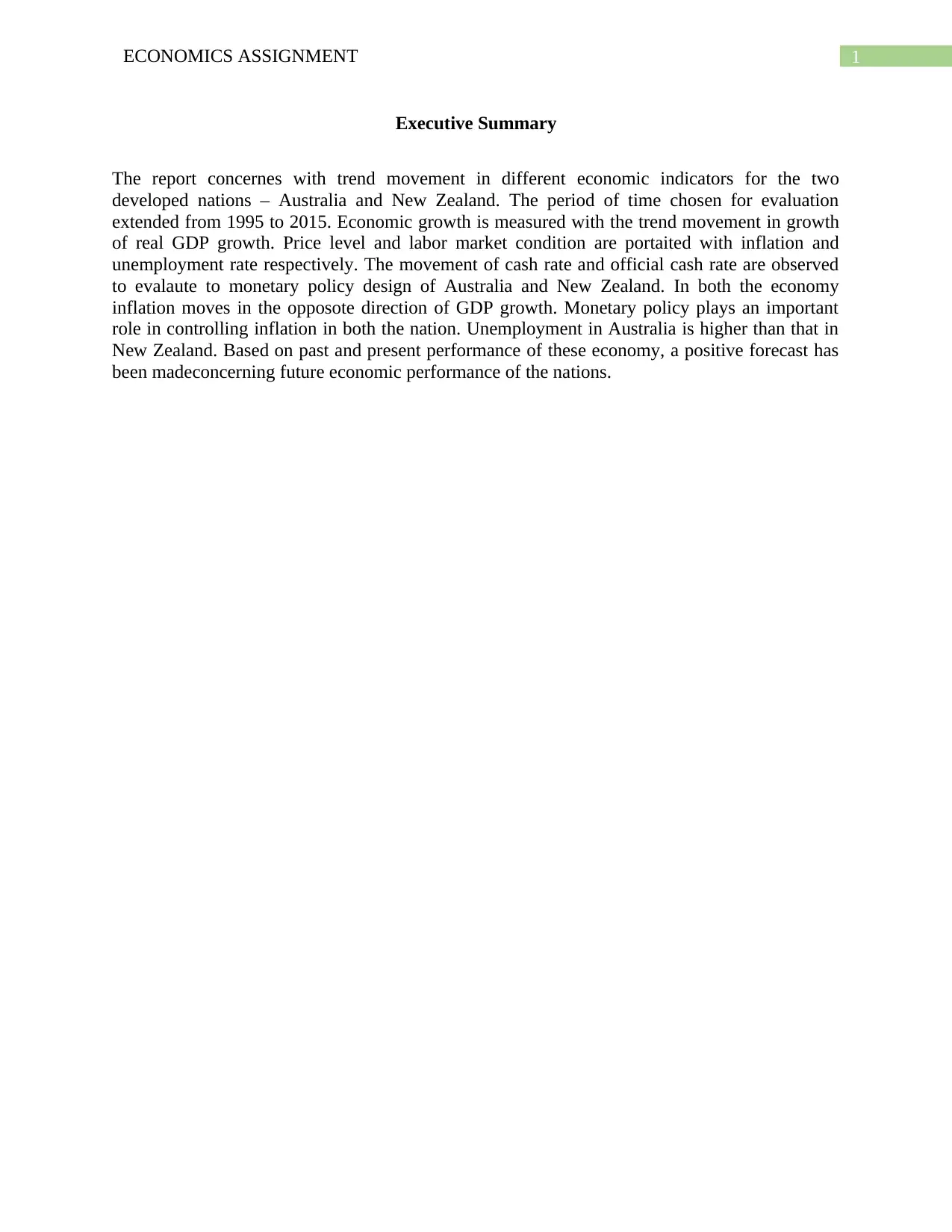
1ECONOMICS ASSIGNMENT
Executive Summary
The report concernes with trend movement in different economic indicators for the two
developed nations – Australia and New Zealand. The period of time chosen for evaluation
extended from 1995 to 2015. Economic growth is measured with the trend movement in growth
of real GDP growth. Price level and labor market condition are portaited with inflation and
unemployment rate respectively. The movement of cash rate and official cash rate are observed
to evalaute to monetary policy design of Australia and New Zealand. In both the economy
inflation moves in the opposote direction of GDP growth. Monetary policy plays an important
role in controlling inflation in both the nation. Unemployment in Australia is higher than that in
New Zealand. Based on past and present performance of these economy, a positive forecast has
been madeconcerning future economic performance of the nations.
Executive Summary
The report concernes with trend movement in different economic indicators for the two
developed nations – Australia and New Zealand. The period of time chosen for evaluation
extended from 1995 to 2015. Economic growth is measured with the trend movement in growth
of real GDP growth. Price level and labor market condition are portaited with inflation and
unemployment rate respectively. The movement of cash rate and official cash rate are observed
to evalaute to monetary policy design of Australia and New Zealand. In both the economy
inflation moves in the opposote direction of GDP growth. Monetary policy plays an important
role in controlling inflation in both the nation. Unemployment in Australia is higher than that in
New Zealand. Based on past and present performance of these economy, a positive forecast has
been madeconcerning future economic performance of the nations.
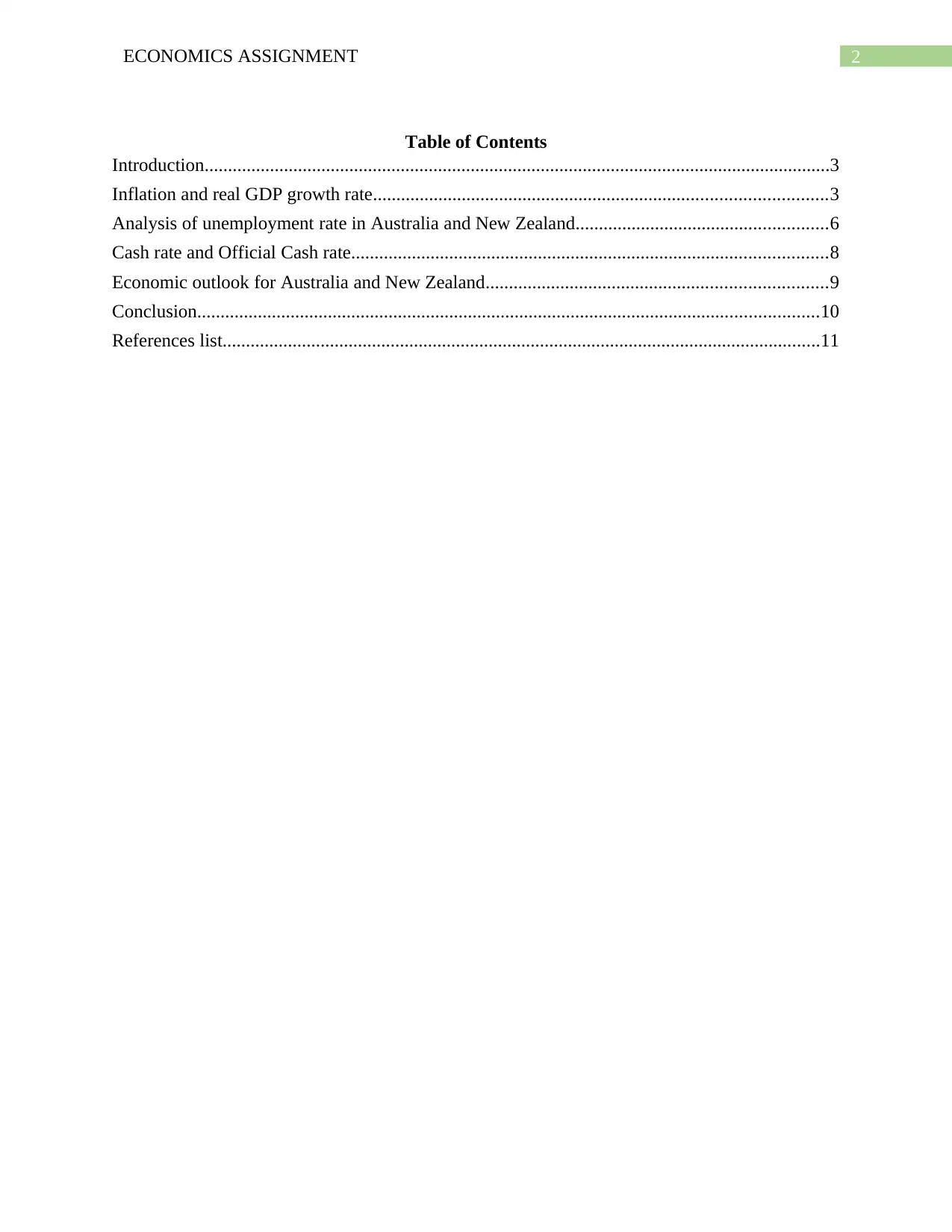
2ECONOMICS ASSIGNMENT
Table of Contents
Introduction......................................................................................................................................3
Inflation and real GDP growth rate.................................................................................................3
Analysis of unemployment rate in Australia and New Zealand......................................................6
Cash rate and Official Cash rate......................................................................................................8
Economic outlook for Australia and New Zealand.........................................................................9
Conclusion.....................................................................................................................................10
References list................................................................................................................................11
Table of Contents
Introduction......................................................................................................................................3
Inflation and real GDP growth rate.................................................................................................3
Analysis of unemployment rate in Australia and New Zealand......................................................6
Cash rate and Official Cash rate......................................................................................................8
Economic outlook for Australia and New Zealand.........................................................................9
Conclusion.....................................................................................................................................10
References list................................................................................................................................11
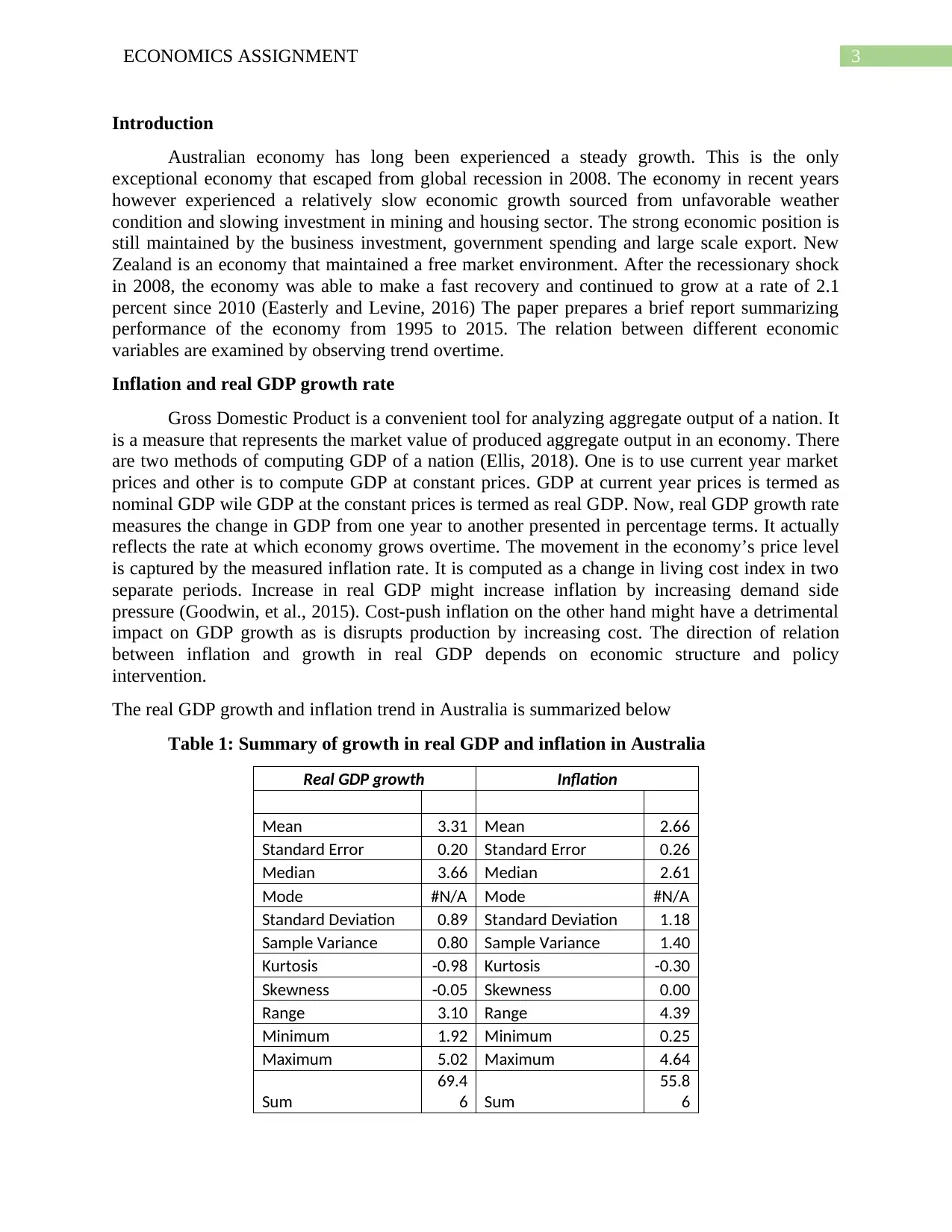
3ECONOMICS ASSIGNMENT
Introduction
Australian economy has long been experienced a steady growth. This is the only
exceptional economy that escaped from global recession in 2008. The economy in recent years
however experienced a relatively slow economic growth sourced from unfavorable weather
condition and slowing investment in mining and housing sector. The strong economic position is
still maintained by the business investment, government spending and large scale export. New
Zealand is an economy that maintained a free market environment. After the recessionary shock
in 2008, the economy was able to make a fast recovery and continued to grow at a rate of 2.1
percent since 2010 (Easterly and Levine, 2016) The paper prepares a brief report summarizing
performance of the economy from 1995 to 2015. The relation between different economic
variables are examined by observing trend overtime.
Inflation and real GDP growth rate
Gross Domestic Product is a convenient tool for analyzing aggregate output of a nation. It
is a measure that represents the market value of produced aggregate output in an economy. There
are two methods of computing GDP of a nation (Ellis, 2018). One is to use current year market
prices and other is to compute GDP at constant prices. GDP at current year prices is termed as
nominal GDP wile GDP at the constant prices is termed as real GDP. Now, real GDP growth rate
measures the change in GDP from one year to another presented in percentage terms. It actually
reflects the rate at which economy grows overtime. The movement in the economy’s price level
is captured by the measured inflation rate. It is computed as a change in living cost index in two
separate periods. Increase in real GDP might increase inflation by increasing demand side
pressure (Goodwin, et al., 2015). Cost-push inflation on the other hand might have a detrimental
impact on GDP growth as is disrupts production by increasing cost. The direction of relation
between inflation and growth in real GDP depends on economic structure and policy
intervention.
The real GDP growth and inflation trend in Australia is summarized below
Table 1: Summary of growth in real GDP and inflation in Australia
Real GDP growth Inflation
Mean 3.31 Mean 2.66
Standard Error 0.20 Standard Error 0.26
Median 3.66 Median 2.61
Mode #N/A Mode #N/A
Standard Deviation 0.89 Standard Deviation 1.18
Sample Variance 0.80 Sample Variance 1.40
Kurtosis -0.98 Kurtosis -0.30
Skewness -0.05 Skewness 0.00
Range 3.10 Range 4.39
Minimum 1.92 Minimum 0.25
Maximum 5.02 Maximum 4.64
Sum
69.4
6 Sum
55.8
6
Introduction
Australian economy has long been experienced a steady growth. This is the only
exceptional economy that escaped from global recession in 2008. The economy in recent years
however experienced a relatively slow economic growth sourced from unfavorable weather
condition and slowing investment in mining and housing sector. The strong economic position is
still maintained by the business investment, government spending and large scale export. New
Zealand is an economy that maintained a free market environment. After the recessionary shock
in 2008, the economy was able to make a fast recovery and continued to grow at a rate of 2.1
percent since 2010 (Easterly and Levine, 2016) The paper prepares a brief report summarizing
performance of the economy from 1995 to 2015. The relation between different economic
variables are examined by observing trend overtime.
Inflation and real GDP growth rate
Gross Domestic Product is a convenient tool for analyzing aggregate output of a nation. It
is a measure that represents the market value of produced aggregate output in an economy. There
are two methods of computing GDP of a nation (Ellis, 2018). One is to use current year market
prices and other is to compute GDP at constant prices. GDP at current year prices is termed as
nominal GDP wile GDP at the constant prices is termed as real GDP. Now, real GDP growth rate
measures the change in GDP from one year to another presented in percentage terms. It actually
reflects the rate at which economy grows overtime. The movement in the economy’s price level
is captured by the measured inflation rate. It is computed as a change in living cost index in two
separate periods. Increase in real GDP might increase inflation by increasing demand side
pressure (Goodwin, et al., 2015). Cost-push inflation on the other hand might have a detrimental
impact on GDP growth as is disrupts production by increasing cost. The direction of relation
between inflation and growth in real GDP depends on economic structure and policy
intervention.
The real GDP growth and inflation trend in Australia is summarized below
Table 1: Summary of growth in real GDP and inflation in Australia
Real GDP growth Inflation
Mean 3.31 Mean 2.66
Standard Error 0.20 Standard Error 0.26
Median 3.66 Median 2.61
Mode #N/A Mode #N/A
Standard Deviation 0.89 Standard Deviation 1.18
Sample Variance 0.80 Sample Variance 1.40
Kurtosis -0.98 Kurtosis -0.30
Skewness -0.05 Skewness 0.00
Range 3.10 Range 4.39
Minimum 1.92 Minimum 0.25
Maximum 5.02 Maximum 4.64
Sum
69.4
6 Sum
55.8
6
Secure Best Marks with AI Grader
Need help grading? Try our AI Grader for instant feedback on your assignments.
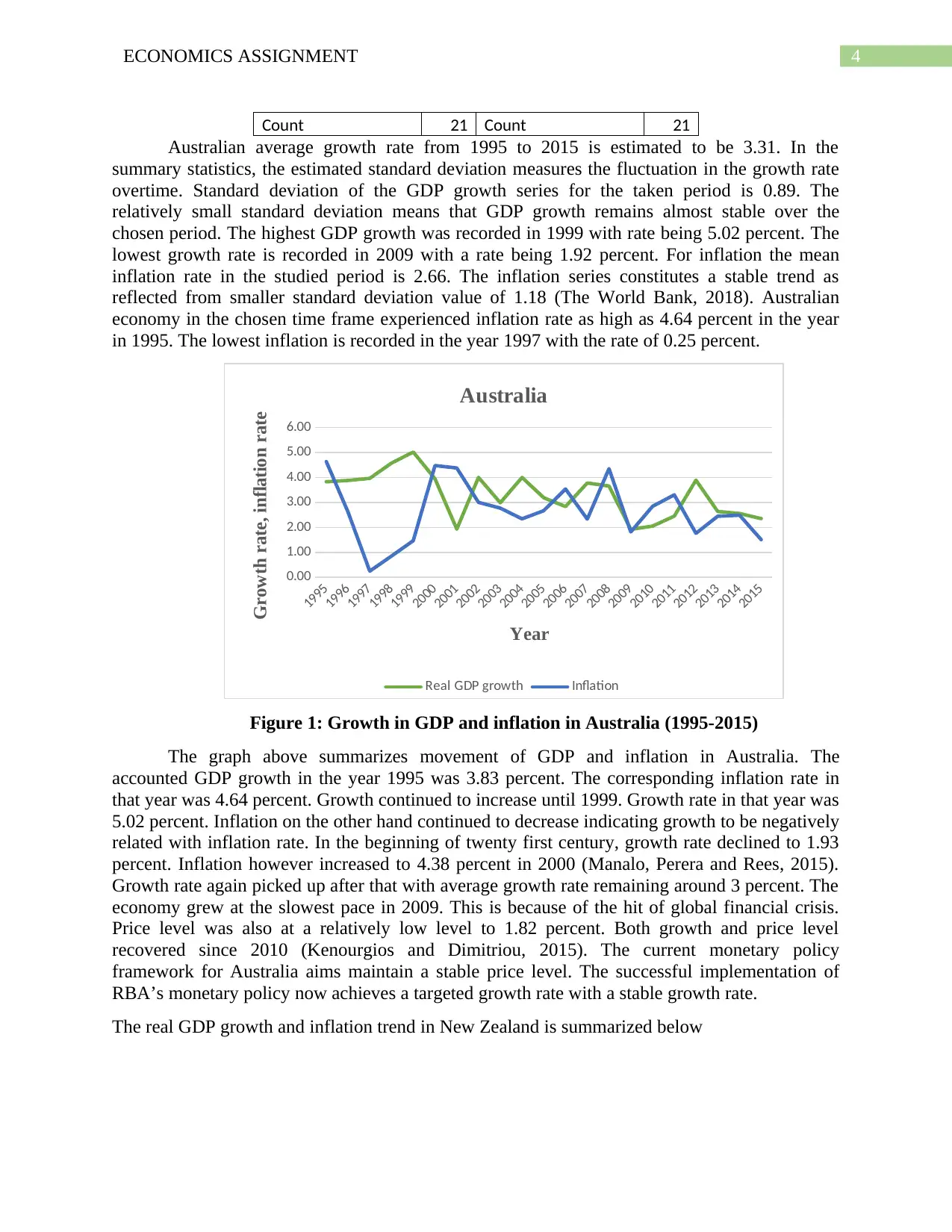
4ECONOMICS ASSIGNMENT
Count 21 Count 21
Australian average growth rate from 1995 to 2015 is estimated to be 3.31. In the
summary statistics, the estimated standard deviation measures the fluctuation in the growth rate
overtime. Standard deviation of the GDP growth series for the taken period is 0.89. The
relatively small standard deviation means that GDP growth remains almost stable over the
chosen period. The highest GDP growth was recorded in 1999 with rate being 5.02 percent. The
lowest growth rate is recorded in 2009 with a rate being 1.92 percent. For inflation the mean
inflation rate in the studied period is 2.66. The inflation series constitutes a stable trend as
reflected from smaller standard deviation value of 1.18 (The World Bank, 2018). Australian
economy in the chosen time frame experienced inflation rate as high as 4.64 percent in the year
in 1995. The lowest inflation is recorded in the year 1997 with the rate of 0.25 percent.
1995
1996
1997
1998
1999
2000
2001
2002
2003
2004
2005
2006
2007
2008
2009
2010
2011
2012
2013
2014
2015
0.00
1.00
2.00
3.00
4.00
5.00
6.00
Australia
Real GDP growth Inflation
Year
Growth rate, inflation rate
Figure 1: Growth in GDP and inflation in Australia (1995-2015)
The graph above summarizes movement of GDP and inflation in Australia. The
accounted GDP growth in the year 1995 was 3.83 percent. The corresponding inflation rate in
that year was 4.64 percent. Growth continued to increase until 1999. Growth rate in that year was
5.02 percent. Inflation on the other hand continued to decrease indicating growth to be negatively
related with inflation rate. In the beginning of twenty first century, growth rate declined to 1.93
percent. Inflation however increased to 4.38 percent in 2000 (Manalo, Perera and Rees, 2015).
Growth rate again picked up after that with average growth rate remaining around 3 percent. The
economy grew at the slowest pace in 2009. This is because of the hit of global financial crisis.
Price level was also at a relatively low level to 1.82 percent. Both growth and price level
recovered since 2010 (Kenourgios and Dimitriou, 2015). The current monetary policy
framework for Australia aims maintain a stable price level. The successful implementation of
RBA’s monetary policy now achieves a targeted growth rate with a stable growth rate.
The real GDP growth and inflation trend in New Zealand is summarized below
Count 21 Count 21
Australian average growth rate from 1995 to 2015 is estimated to be 3.31. In the
summary statistics, the estimated standard deviation measures the fluctuation in the growth rate
overtime. Standard deviation of the GDP growth series for the taken period is 0.89. The
relatively small standard deviation means that GDP growth remains almost stable over the
chosen period. The highest GDP growth was recorded in 1999 with rate being 5.02 percent. The
lowest growth rate is recorded in 2009 with a rate being 1.92 percent. For inflation the mean
inflation rate in the studied period is 2.66. The inflation series constitutes a stable trend as
reflected from smaller standard deviation value of 1.18 (The World Bank, 2018). Australian
economy in the chosen time frame experienced inflation rate as high as 4.64 percent in the year
in 1995. The lowest inflation is recorded in the year 1997 with the rate of 0.25 percent.
1995
1996
1997
1998
1999
2000
2001
2002
2003
2004
2005
2006
2007
2008
2009
2010
2011
2012
2013
2014
2015
0.00
1.00
2.00
3.00
4.00
5.00
6.00
Australia
Real GDP growth Inflation
Year
Growth rate, inflation rate
Figure 1: Growth in GDP and inflation in Australia (1995-2015)
The graph above summarizes movement of GDP and inflation in Australia. The
accounted GDP growth in the year 1995 was 3.83 percent. The corresponding inflation rate in
that year was 4.64 percent. Growth continued to increase until 1999. Growth rate in that year was
5.02 percent. Inflation on the other hand continued to decrease indicating growth to be negatively
related with inflation rate. In the beginning of twenty first century, growth rate declined to 1.93
percent. Inflation however increased to 4.38 percent in 2000 (Manalo, Perera and Rees, 2015).
Growth rate again picked up after that with average growth rate remaining around 3 percent. The
economy grew at the slowest pace in 2009. This is because of the hit of global financial crisis.
Price level was also at a relatively low level to 1.82 percent. Both growth and price level
recovered since 2010 (Kenourgios and Dimitriou, 2015). The current monetary policy
framework for Australia aims maintain a stable price level. The successful implementation of
RBA’s monetary policy now achieves a targeted growth rate with a stable growth rate.
The real GDP growth and inflation trend in New Zealand is summarized below
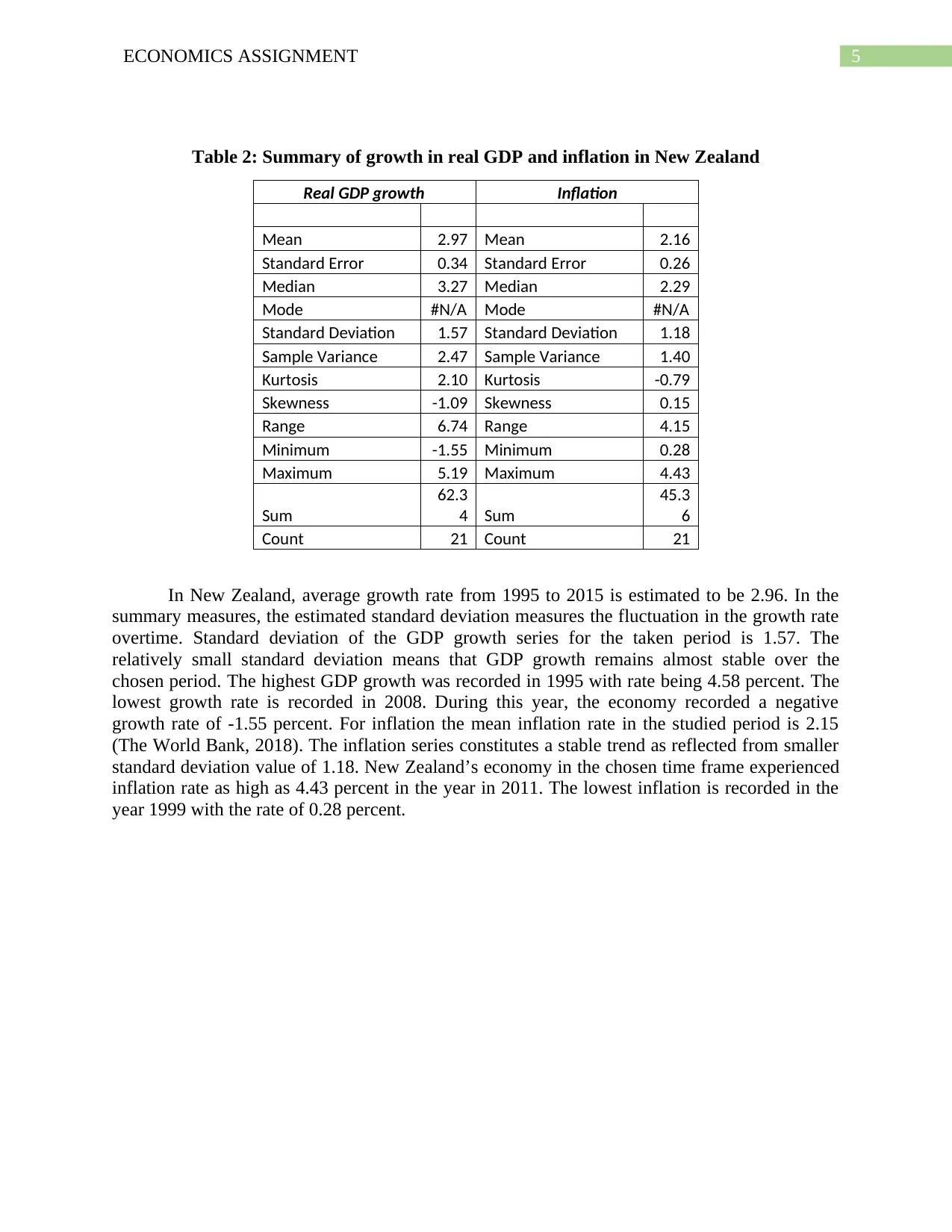
5ECONOMICS ASSIGNMENT
Table 2: Summary of growth in real GDP and inflation in New Zealand
Real GDP growth Inflation
Mean 2.97 Mean 2.16
Standard Error 0.34 Standard Error 0.26
Median 3.27 Median 2.29
Mode #N/A Mode #N/A
Standard Deviation 1.57 Standard Deviation 1.18
Sample Variance 2.47 Sample Variance 1.40
Kurtosis 2.10 Kurtosis -0.79
Skewness -1.09 Skewness 0.15
Range 6.74 Range 4.15
Minimum -1.55 Minimum 0.28
Maximum 5.19 Maximum 4.43
Sum
62.3
4 Sum
45.3
6
Count 21 Count 21
In New Zealand, average growth rate from 1995 to 2015 is estimated to be 2.96. In the
summary measures, the estimated standard deviation measures the fluctuation in the growth rate
overtime. Standard deviation of the GDP growth series for the taken period is 1.57. The
relatively small standard deviation means that GDP growth remains almost stable over the
chosen period. The highest GDP growth was recorded in 1995 with rate being 4.58 percent. The
lowest growth rate is recorded in 2008. During this year, the economy recorded a negative
growth rate of -1.55 percent. For inflation the mean inflation rate in the studied period is 2.15
(The World Bank, 2018). The inflation series constitutes a stable trend as reflected from smaller
standard deviation value of 1.18. New Zealand’s economy in the chosen time frame experienced
inflation rate as high as 4.43 percent in the year in 2011. The lowest inflation is recorded in the
year 1999 with the rate of 0.28 percent.
Table 2: Summary of growth in real GDP and inflation in New Zealand
Real GDP growth Inflation
Mean 2.97 Mean 2.16
Standard Error 0.34 Standard Error 0.26
Median 3.27 Median 2.29
Mode #N/A Mode #N/A
Standard Deviation 1.57 Standard Deviation 1.18
Sample Variance 2.47 Sample Variance 1.40
Kurtosis 2.10 Kurtosis -0.79
Skewness -1.09 Skewness 0.15
Range 6.74 Range 4.15
Minimum -1.55 Minimum 0.28
Maximum 5.19 Maximum 4.43
Sum
62.3
4 Sum
45.3
6
Count 21 Count 21
In New Zealand, average growth rate from 1995 to 2015 is estimated to be 2.96. In the
summary measures, the estimated standard deviation measures the fluctuation in the growth rate
overtime. Standard deviation of the GDP growth series for the taken period is 1.57. The
relatively small standard deviation means that GDP growth remains almost stable over the
chosen period. The highest GDP growth was recorded in 1995 with rate being 4.58 percent. The
lowest growth rate is recorded in 2008. During this year, the economy recorded a negative
growth rate of -1.55 percent. For inflation the mean inflation rate in the studied period is 2.15
(The World Bank, 2018). The inflation series constitutes a stable trend as reflected from smaller
standard deviation value of 1.18. New Zealand’s economy in the chosen time frame experienced
inflation rate as high as 4.43 percent in the year in 2011. The lowest inflation is recorded in the
year 1999 with the rate of 0.28 percent.
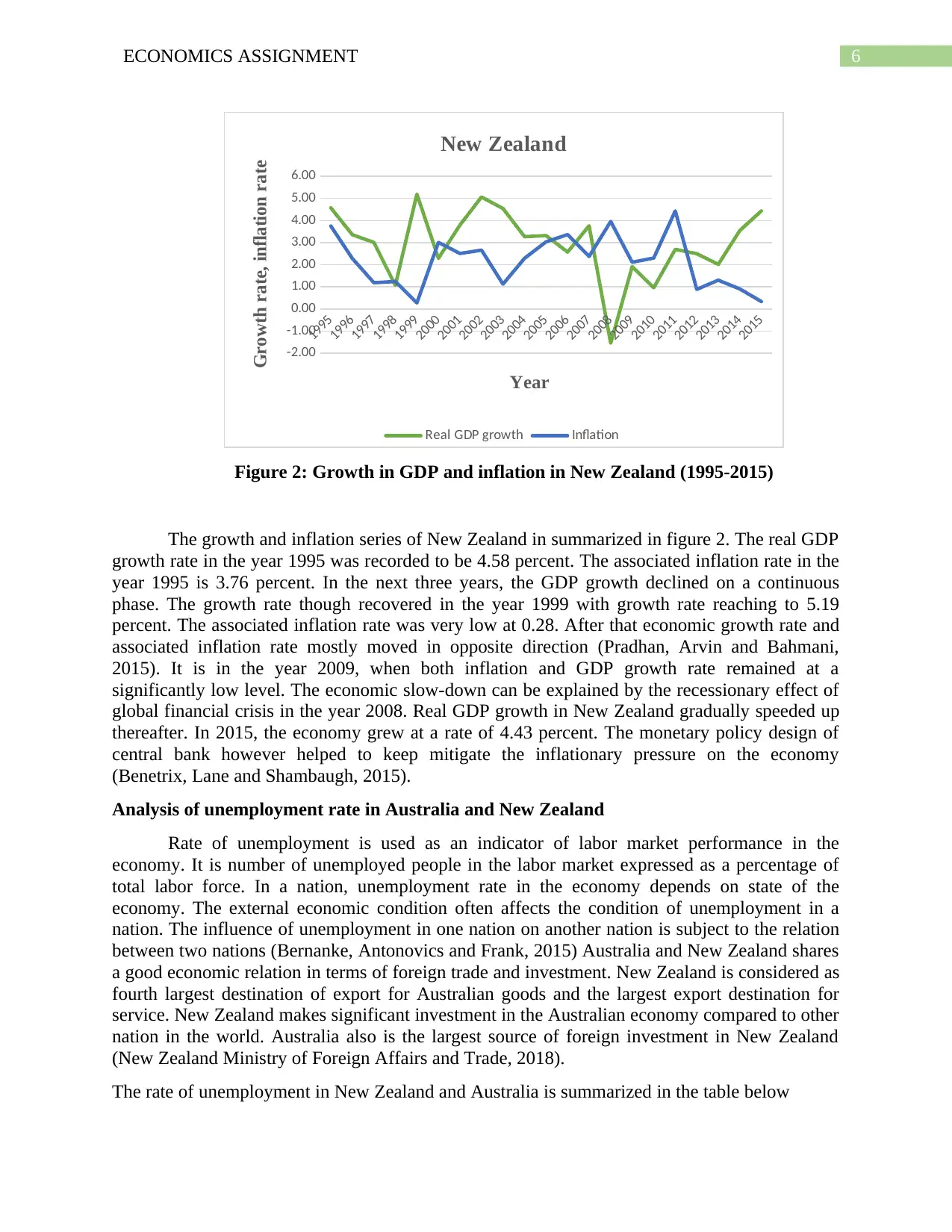
6ECONOMICS ASSIGNMENT
1995
1996
1997
1998
1999
2000
2001
2002
2003
2004
2005
2006
2007
2008
2009
2010
2011
2012
2013
2014
2015
-2.00
-1.00
0.00
1.00
2.00
3.00
4.00
5.00
6.00
New Zealand
Real GDP growth Inflation
Year
Growth rate, inflation rate
Figure 2: Growth in GDP and inflation in New Zealand (1995-2015)
The growth and inflation series of New Zealand in summarized in figure 2. The real GDP
growth rate in the year 1995 was recorded to be 4.58 percent. The associated inflation rate in the
year 1995 is 3.76 percent. In the next three years, the GDP growth declined on a continuous
phase. The growth rate though recovered in the year 1999 with growth rate reaching to 5.19
percent. The associated inflation rate was very low at 0.28. After that economic growth rate and
associated inflation rate mostly moved in opposite direction (Pradhan, Arvin and Bahmani,
2015). It is in the year 2009, when both inflation and GDP growth rate remained at a
significantly low level. The economic slow-down can be explained by the recessionary effect of
global financial crisis in the year 2008. Real GDP growth in New Zealand gradually speeded up
thereafter. In 2015, the economy grew at a rate of 4.43 percent. The monetary policy design of
central bank however helped to keep mitigate the inflationary pressure on the economy
(Benetrix, Lane and Shambaugh, 2015).
Analysis of unemployment rate in Australia and New Zealand
Rate of unemployment is used as an indicator of labor market performance in the
economy. It is number of unemployed people in the labor market expressed as a percentage of
total labor force. In a nation, unemployment rate in the economy depends on state of the
economy. The external economic condition often affects the condition of unemployment in a
nation. The influence of unemployment in one nation on another nation is subject to the relation
between two nations (Bernanke, Antonovics and Frank, 2015) Australia and New Zealand shares
a good economic relation in terms of foreign trade and investment. New Zealand is considered as
fourth largest destination of export for Australian goods and the largest export destination for
service. New Zealand makes significant investment in the Australian economy compared to other
nation in the world. Australia also is the largest source of foreign investment in New Zealand
(New Zealand Ministry of Foreign Affairs and Trade, 2018).
The rate of unemployment in New Zealand and Australia is summarized in the table below
1995
1996
1997
1998
1999
2000
2001
2002
2003
2004
2005
2006
2007
2008
2009
2010
2011
2012
2013
2014
2015
-2.00
-1.00
0.00
1.00
2.00
3.00
4.00
5.00
6.00
New Zealand
Real GDP growth Inflation
Year
Growth rate, inflation rate
Figure 2: Growth in GDP and inflation in New Zealand (1995-2015)
The growth and inflation series of New Zealand in summarized in figure 2. The real GDP
growth rate in the year 1995 was recorded to be 4.58 percent. The associated inflation rate in the
year 1995 is 3.76 percent. In the next three years, the GDP growth declined on a continuous
phase. The growth rate though recovered in the year 1999 with growth rate reaching to 5.19
percent. The associated inflation rate was very low at 0.28. After that economic growth rate and
associated inflation rate mostly moved in opposite direction (Pradhan, Arvin and Bahmani,
2015). It is in the year 2009, when both inflation and GDP growth rate remained at a
significantly low level. The economic slow-down can be explained by the recessionary effect of
global financial crisis in the year 2008. Real GDP growth in New Zealand gradually speeded up
thereafter. In 2015, the economy grew at a rate of 4.43 percent. The monetary policy design of
central bank however helped to keep mitigate the inflationary pressure on the economy
(Benetrix, Lane and Shambaugh, 2015).
Analysis of unemployment rate in Australia and New Zealand
Rate of unemployment is used as an indicator of labor market performance in the
economy. It is number of unemployed people in the labor market expressed as a percentage of
total labor force. In a nation, unemployment rate in the economy depends on state of the
economy. The external economic condition often affects the condition of unemployment in a
nation. The influence of unemployment in one nation on another nation is subject to the relation
between two nations (Bernanke, Antonovics and Frank, 2015) Australia and New Zealand shares
a good economic relation in terms of foreign trade and investment. New Zealand is considered as
fourth largest destination of export for Australian goods and the largest export destination for
service. New Zealand makes significant investment in the Australian economy compared to other
nation in the world. Australia also is the largest source of foreign investment in New Zealand
(New Zealand Ministry of Foreign Affairs and Trade, 2018).
The rate of unemployment in New Zealand and Australia is summarized in the table below
Paraphrase This Document
Need a fresh take? Get an instant paraphrase of this document with our AI Paraphraser
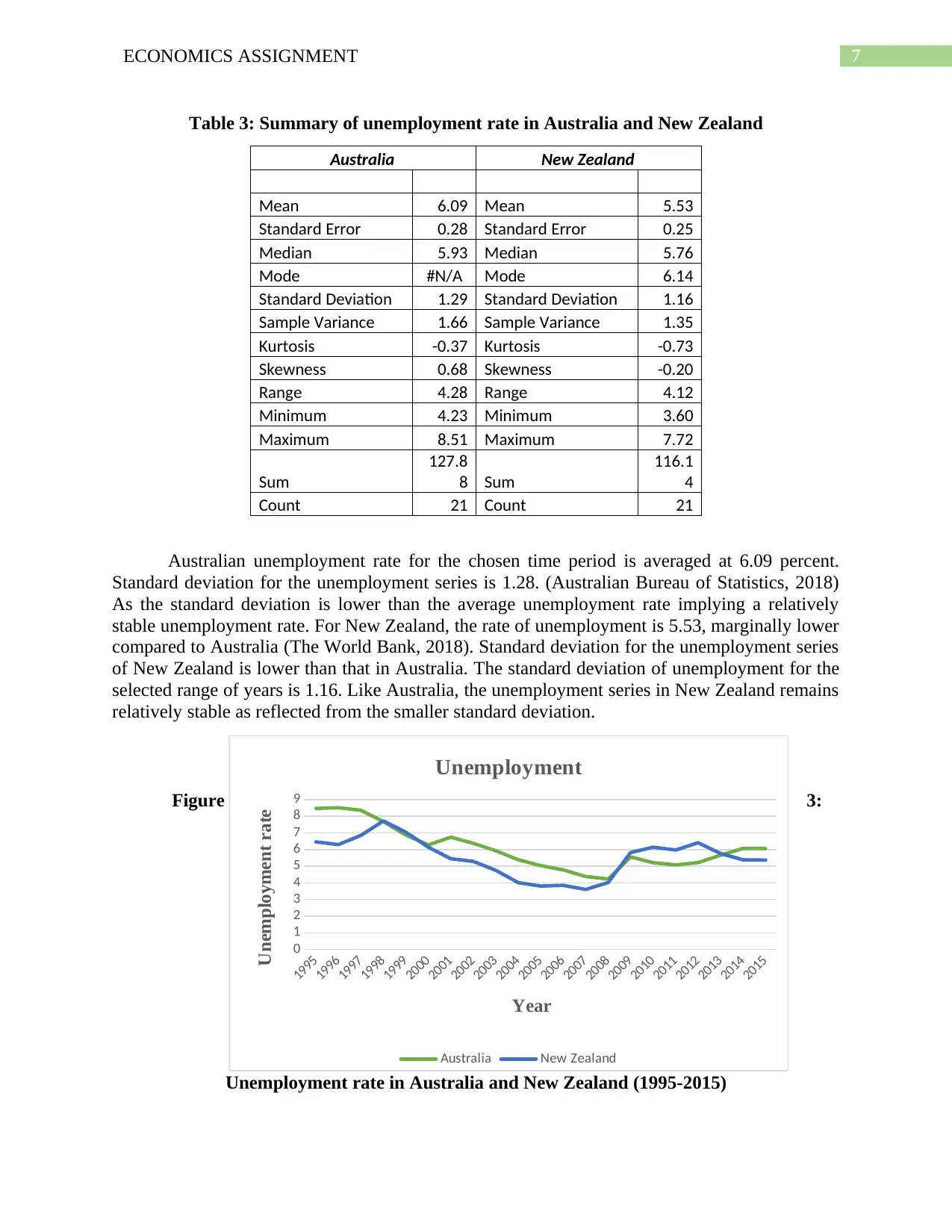
7ECONOMICS ASSIGNMENT
Table 3: Summary of unemployment rate in Australia and New Zealand
Australia New Zealand
Mean 6.09 Mean 5.53
Standard Error 0.28 Standard Error 0.25
Median 5.93 Median 5.76
Mode #N/A Mode 6.14
Standard Deviation 1.29 Standard Deviation 1.16
Sample Variance 1.66 Sample Variance 1.35
Kurtosis -0.37 Kurtosis -0.73
Skewness 0.68 Skewness -0.20
Range 4.28 Range 4.12
Minimum 4.23 Minimum 3.60
Maximum 8.51 Maximum 7.72
Sum
127.8
8 Sum
116.1
4
Count 21 Count 21
Australian unemployment rate for the chosen time period is averaged at 6.09 percent.
Standard deviation for the unemployment series is 1.28. (Australian Bureau of Statistics, 2018)
As the standard deviation is lower than the average unemployment rate implying a relatively
stable unemployment rate. For New Zealand, the rate of unemployment is 5.53, marginally lower
compared to Australia (The World Bank, 2018). Standard deviation for the unemployment series
of New Zealand is lower than that in Australia. The standard deviation of unemployment for the
selected range of years is 1.16. Like Australia, the unemployment series in New Zealand remains
relatively stable as reflected from the smaller standard deviation.
Figure 3:
Unemployment rate in Australia and New Zealand (1995-2015)
1995
1996
1997
1998
1999
2000
2001
2002
2003
2004
2005
2006
2007
2008
2009
2010
2011
2012
2013
2014
2015
0
1
2
3
4
5
6
7
8
9
Unemployment
Australia New Zealand
Year
Unemployment rate
Table 3: Summary of unemployment rate in Australia and New Zealand
Australia New Zealand
Mean 6.09 Mean 5.53
Standard Error 0.28 Standard Error 0.25
Median 5.93 Median 5.76
Mode #N/A Mode 6.14
Standard Deviation 1.29 Standard Deviation 1.16
Sample Variance 1.66 Sample Variance 1.35
Kurtosis -0.37 Kurtosis -0.73
Skewness 0.68 Skewness -0.20
Range 4.28 Range 4.12
Minimum 4.23 Minimum 3.60
Maximum 8.51 Maximum 7.72
Sum
127.8
8 Sum
116.1
4
Count 21 Count 21
Australian unemployment rate for the chosen time period is averaged at 6.09 percent.
Standard deviation for the unemployment series is 1.28. (Australian Bureau of Statistics, 2018)
As the standard deviation is lower than the average unemployment rate implying a relatively
stable unemployment rate. For New Zealand, the rate of unemployment is 5.53, marginally lower
compared to Australia (The World Bank, 2018). Standard deviation for the unemployment series
of New Zealand is lower than that in Australia. The standard deviation of unemployment for the
selected range of years is 1.16. Like Australia, the unemployment series in New Zealand remains
relatively stable as reflected from the smaller standard deviation.
Figure 3:
Unemployment rate in Australia and New Zealand (1995-2015)
1995
1996
1997
1998
1999
2000
2001
2002
2003
2004
2005
2006
2007
2008
2009
2010
2011
2012
2013
2014
2015
0
1
2
3
4
5
6
7
8
9
Unemployment
Australia New Zealand
Year
Unemployment rate
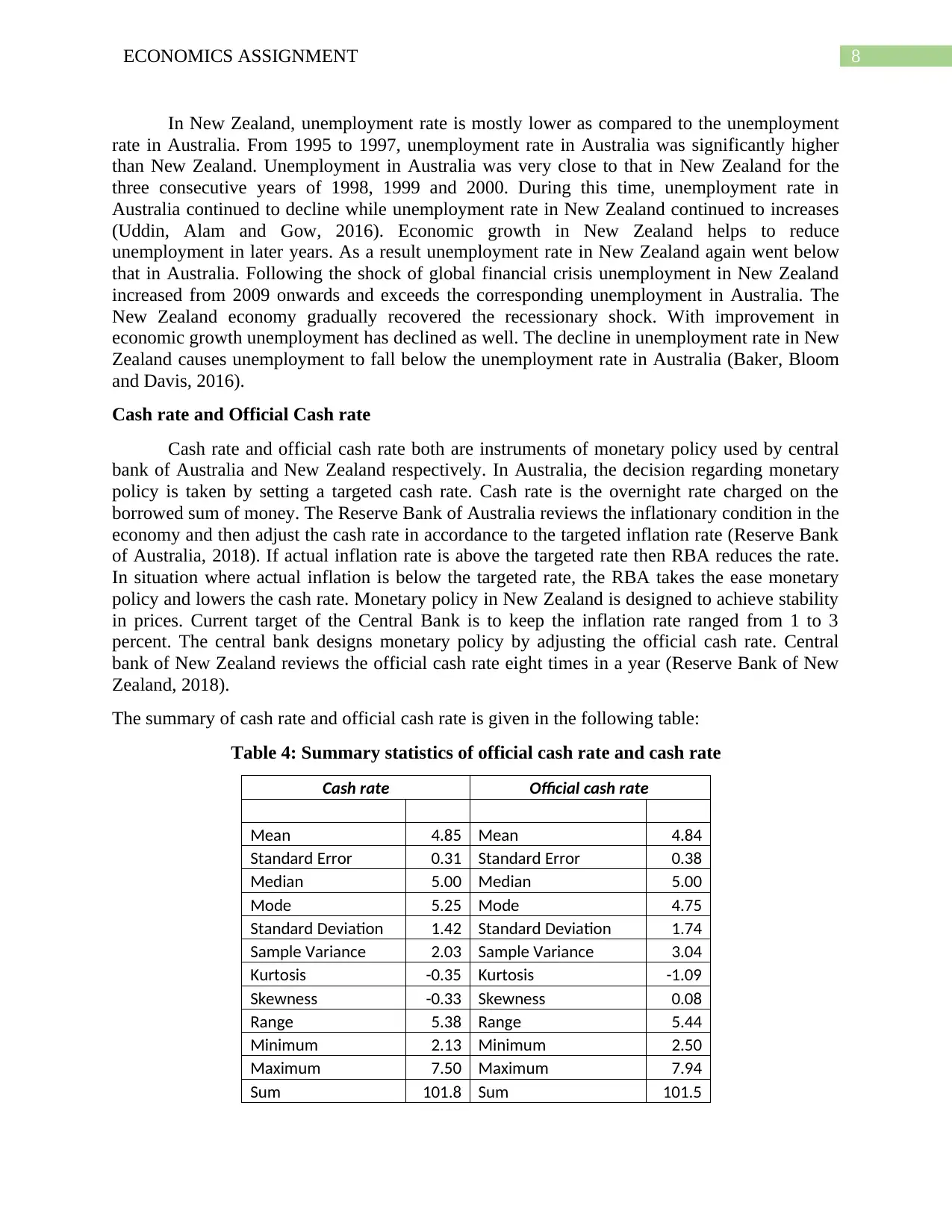
8ECONOMICS ASSIGNMENT
In New Zealand, unemployment rate is mostly lower as compared to the unemployment
rate in Australia. From 1995 to 1997, unemployment rate in Australia was significantly higher
than New Zealand. Unemployment in Australia was very close to that in New Zealand for the
three consecutive years of 1998, 1999 and 2000. During this time, unemployment rate in
Australia continued to decline while unemployment rate in New Zealand continued to increases
(Uddin, Alam and Gow, 2016). Economic growth in New Zealand helps to reduce
unemployment in later years. As a result unemployment rate in New Zealand again went below
that in Australia. Following the shock of global financial crisis unemployment in New Zealand
increased from 2009 onwards and exceeds the corresponding unemployment in Australia. The
New Zealand economy gradually recovered the recessionary shock. With improvement in
economic growth unemployment has declined as well. The decline in unemployment rate in New
Zealand causes unemployment to fall below the unemployment rate in Australia (Baker, Bloom
and Davis, 2016).
Cash rate and Official Cash rate
Cash rate and official cash rate both are instruments of monetary policy used by central
bank of Australia and New Zealand respectively. In Australia, the decision regarding monetary
policy is taken by setting a targeted cash rate. Cash rate is the overnight rate charged on the
borrowed sum of money. The Reserve Bank of Australia reviews the inflationary condition in the
economy and then adjust the cash rate in accordance to the targeted inflation rate (Reserve Bank
of Australia, 2018). If actual inflation rate is above the targeted rate then RBA reduces the rate.
In situation where actual inflation is below the targeted rate, the RBA takes the ease monetary
policy and lowers the cash rate. Monetary policy in New Zealand is designed to achieve stability
in prices. Current target of the Central Bank is to keep the inflation rate ranged from 1 to 3
percent. The central bank designs monetary policy by adjusting the official cash rate. Central
bank of New Zealand reviews the official cash rate eight times in a year (Reserve Bank of New
Zealand, 2018).
The summary of cash rate and official cash rate is given in the following table:
Table 4: Summary statistics of official cash rate and cash rate
Cash rate Official cash rate
Mean 4.85 Mean 4.84
Standard Error 0.31 Standard Error 0.38
Median 5.00 Median 5.00
Mode 5.25 Mode 4.75
Standard Deviation 1.42 Standard Deviation 1.74
Sample Variance 2.03 Sample Variance 3.04
Kurtosis -0.35 Kurtosis -1.09
Skewness -0.33 Skewness 0.08
Range 5.38 Range 5.44
Minimum 2.13 Minimum 2.50
Maximum 7.50 Maximum 7.94
Sum 101.8 Sum 101.5
In New Zealand, unemployment rate is mostly lower as compared to the unemployment
rate in Australia. From 1995 to 1997, unemployment rate in Australia was significantly higher
than New Zealand. Unemployment in Australia was very close to that in New Zealand for the
three consecutive years of 1998, 1999 and 2000. During this time, unemployment rate in
Australia continued to decline while unemployment rate in New Zealand continued to increases
(Uddin, Alam and Gow, 2016). Economic growth in New Zealand helps to reduce
unemployment in later years. As a result unemployment rate in New Zealand again went below
that in Australia. Following the shock of global financial crisis unemployment in New Zealand
increased from 2009 onwards and exceeds the corresponding unemployment in Australia. The
New Zealand economy gradually recovered the recessionary shock. With improvement in
economic growth unemployment has declined as well. The decline in unemployment rate in New
Zealand causes unemployment to fall below the unemployment rate in Australia (Baker, Bloom
and Davis, 2016).
Cash rate and Official Cash rate
Cash rate and official cash rate both are instruments of monetary policy used by central
bank of Australia and New Zealand respectively. In Australia, the decision regarding monetary
policy is taken by setting a targeted cash rate. Cash rate is the overnight rate charged on the
borrowed sum of money. The Reserve Bank of Australia reviews the inflationary condition in the
economy and then adjust the cash rate in accordance to the targeted inflation rate (Reserve Bank
of Australia, 2018). If actual inflation rate is above the targeted rate then RBA reduces the rate.
In situation where actual inflation is below the targeted rate, the RBA takes the ease monetary
policy and lowers the cash rate. Monetary policy in New Zealand is designed to achieve stability
in prices. Current target of the Central Bank is to keep the inflation rate ranged from 1 to 3
percent. The central bank designs monetary policy by adjusting the official cash rate. Central
bank of New Zealand reviews the official cash rate eight times in a year (Reserve Bank of New
Zealand, 2018).
The summary of cash rate and official cash rate is given in the following table:
Table 4: Summary statistics of official cash rate and cash rate
Cash rate Official cash rate
Mean 4.85 Mean 4.84
Standard Error 0.31 Standard Error 0.38
Median 5.00 Median 5.00
Mode 5.25 Mode 4.75
Standard Deviation 1.42 Standard Deviation 1.74
Sample Variance 2.03 Sample Variance 3.04
Kurtosis -0.35 Kurtosis -1.09
Skewness -0.33 Skewness 0.08
Range 5.38 Range 5.44
Minimum 2.13 Minimum 2.50
Maximum 7.50 Maximum 7.94
Sum 101.8 Sum 101.5

9ECONOMICS ASSIGNMENT
1 9
Count 21 Count 21
The average overnight rate in Australia is almost same as that in New Zealand. The
average cash rate is obtained as 4.85. The same for Official Cash Rate is 4.84. For both the series
of cash rate and official cash rate standard deviation is less than that of the average overnight rate
implying the central bank in both Australia and New Zealand has maintained a relatively stable
trend in the cash rate.
1995
1996
1997
1998
1999
2000
2001
2002
2003
2004
2005
2006
2007
2008
2009
2010
2011
2012
2013
2014
2015
0.00
1.00
2.00
3.00
4.00
5.00
6.00
7.00
8.00
9.00
Cash rate and Official cash rate
Cash rate Official cash rate
Year
Interest rate
Figure 4: Trend in cash rate and official cash rate (1995-2015)
Previously, cash rate and official cash rate constitutes the same trend. It was then
believed that the Central Bank’s policy in New Zealand follows the policy initiative taken by
central bank of Australia. The leader followers’ trend in designing monetary policy however
marked a break at the ending note of 2001 (Murray, 2017) The monetary policy coordination
between the two nations had broken down since then. In the may quarter of 2002 central bank of
both the nation took the independent decision of implementing a tight monetary policy. The
central bank of New Zealand increased the cash rate by 0.25 basis point with the cash rate
becoming 5.00 percent. During this time Reserve Bank of Australia also raised the cash rate from
4.25 in April, 2002 to 4.50 in May, 2002. The decision in New Zealand however was taken in
advance to that in Australia. Both the nation again took a coordinated decision of lowering the
interest rate in 2006. In New Zealand, the official cash rate ranged around 3 percent. The same in
Australia during that period averaged around 2 percent.
In the phase of tight monetary policy, Reserve Bank raises the overnight cash rate. The
higher increases rate by increasing the cost of borrowed fund restricts economic activity and
control inflationary pressure (Heijdra, 2017). As evidenced from the data series of cash rate and
official cash rate, in the past decade the settled bank rate in New Zealand is higher as compared
to cash rate in Australia. The economic growth is relatively stronger in New Zealand. The slow
growth rate in Australia induces the Reserve Bank to set the interest rate at a relatively low level.
1 9
Count 21 Count 21
The average overnight rate in Australia is almost same as that in New Zealand. The
average cash rate is obtained as 4.85. The same for Official Cash Rate is 4.84. For both the series
of cash rate and official cash rate standard deviation is less than that of the average overnight rate
implying the central bank in both Australia and New Zealand has maintained a relatively stable
trend in the cash rate.
1995
1996
1997
1998
1999
2000
2001
2002
2003
2004
2005
2006
2007
2008
2009
2010
2011
2012
2013
2014
2015
0.00
1.00
2.00
3.00
4.00
5.00
6.00
7.00
8.00
9.00
Cash rate and Official cash rate
Cash rate Official cash rate
Year
Interest rate
Figure 4: Trend in cash rate and official cash rate (1995-2015)
Previously, cash rate and official cash rate constitutes the same trend. It was then
believed that the Central Bank’s policy in New Zealand follows the policy initiative taken by
central bank of Australia. The leader followers’ trend in designing monetary policy however
marked a break at the ending note of 2001 (Murray, 2017) The monetary policy coordination
between the two nations had broken down since then. In the may quarter of 2002 central bank of
both the nation took the independent decision of implementing a tight monetary policy. The
central bank of New Zealand increased the cash rate by 0.25 basis point with the cash rate
becoming 5.00 percent. During this time Reserve Bank of Australia also raised the cash rate from
4.25 in April, 2002 to 4.50 in May, 2002. The decision in New Zealand however was taken in
advance to that in Australia. Both the nation again took a coordinated decision of lowering the
interest rate in 2006. In New Zealand, the official cash rate ranged around 3 percent. The same in
Australia during that period averaged around 2 percent.
In the phase of tight monetary policy, Reserve Bank raises the overnight cash rate. The
higher increases rate by increasing the cost of borrowed fund restricts economic activity and
control inflationary pressure (Heijdra, 2017). As evidenced from the data series of cash rate and
official cash rate, in the past decade the settled bank rate in New Zealand is higher as compared
to cash rate in Australia. The economic growth is relatively stronger in New Zealand. The slow
growth rate in Australia induces the Reserve Bank to set the interest rate at a relatively low level.
Secure Best Marks with AI Grader
Need help grading? Try our AI Grader for instant feedback on your assignments.
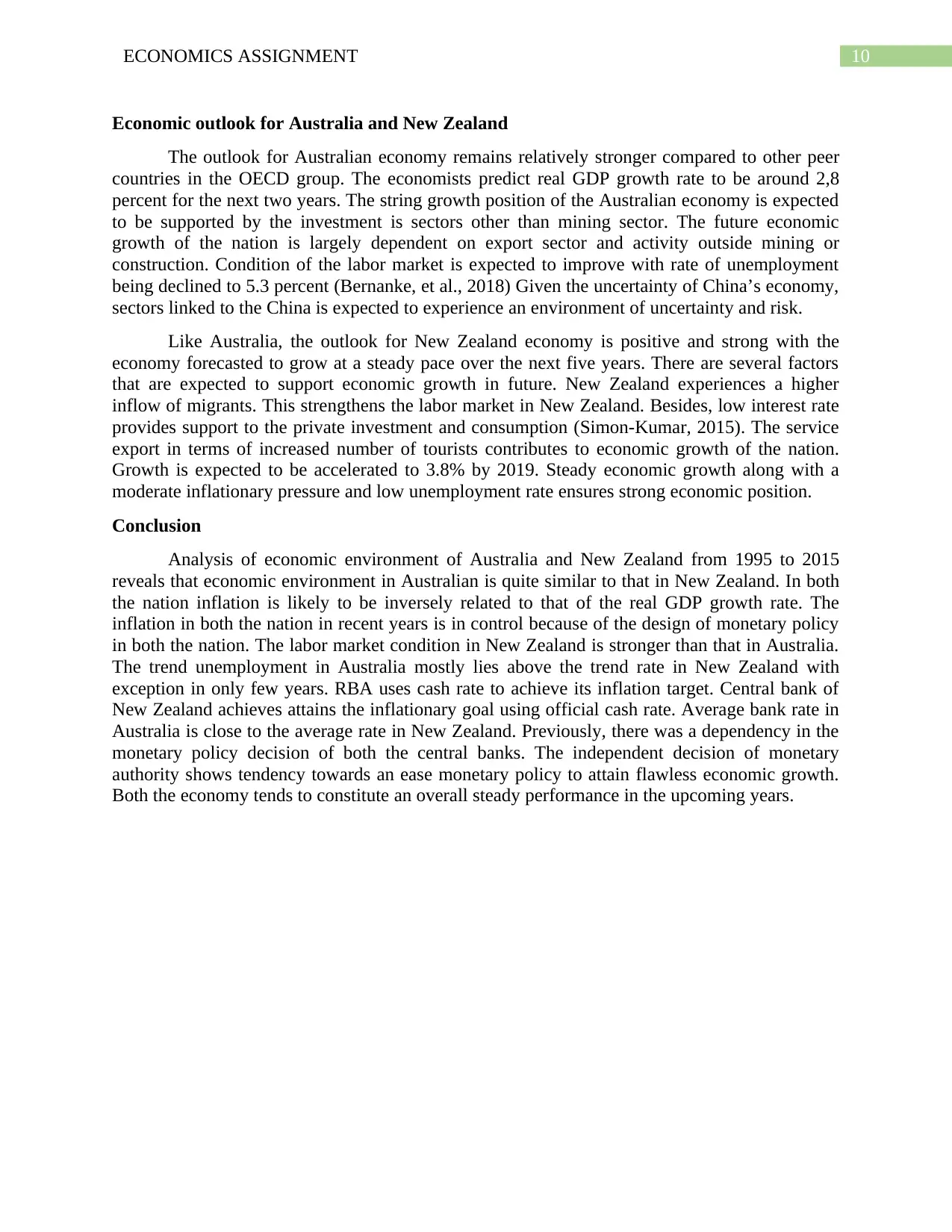
10ECONOMICS ASSIGNMENT
Economic outlook for Australia and New Zealand
The outlook for Australian economy remains relatively stronger compared to other peer
countries in the OECD group. The economists predict real GDP growth rate to be around 2,8
percent for the next two years. The string growth position of the Australian economy is expected
to be supported by the investment is sectors other than mining sector. The future economic
growth of the nation is largely dependent on export sector and activity outside mining or
construction. Condition of the labor market is expected to improve with rate of unemployment
being declined to 5.3 percent (Bernanke, et al., 2018) Given the uncertainty of China’s economy,
sectors linked to the China is expected to experience an environment of uncertainty and risk.
Like Australia, the outlook for New Zealand economy is positive and strong with the
economy forecasted to grow at a steady pace over the next five years. There are several factors
that are expected to support economic growth in future. New Zealand experiences a higher
inflow of migrants. This strengthens the labor market in New Zealand. Besides, low interest rate
provides support to the private investment and consumption (Simon-Kumar, 2015). The service
export in terms of increased number of tourists contributes to economic growth of the nation.
Growth is expected to be accelerated to 3.8% by 2019. Steady economic growth along with a
moderate inflationary pressure and low unemployment rate ensures strong economic position.
Conclusion
Analysis of economic environment of Australia and New Zealand from 1995 to 2015
reveals that economic environment in Australian is quite similar to that in New Zealand. In both
the nation inflation is likely to be inversely related to that of the real GDP growth rate. The
inflation in both the nation in recent years is in control because of the design of monetary policy
in both the nation. The labor market condition in New Zealand is stronger than that in Australia.
The trend unemployment in Australia mostly lies above the trend rate in New Zealand with
exception in only few years. RBA uses cash rate to achieve its inflation target. Central bank of
New Zealand achieves attains the inflationary goal using official cash rate. Average bank rate in
Australia is close to the average rate in New Zealand. Previously, there was a dependency in the
monetary policy decision of both the central banks. The independent decision of monetary
authority shows tendency towards an ease monetary policy to attain flawless economic growth.
Both the economy tends to constitute an overall steady performance in the upcoming years.
Economic outlook for Australia and New Zealand
The outlook for Australian economy remains relatively stronger compared to other peer
countries in the OECD group. The economists predict real GDP growth rate to be around 2,8
percent for the next two years. The string growth position of the Australian economy is expected
to be supported by the investment is sectors other than mining sector. The future economic
growth of the nation is largely dependent on export sector and activity outside mining or
construction. Condition of the labor market is expected to improve with rate of unemployment
being declined to 5.3 percent (Bernanke, et al., 2018) Given the uncertainty of China’s economy,
sectors linked to the China is expected to experience an environment of uncertainty and risk.
Like Australia, the outlook for New Zealand economy is positive and strong with the
economy forecasted to grow at a steady pace over the next five years. There are several factors
that are expected to support economic growth in future. New Zealand experiences a higher
inflow of migrants. This strengthens the labor market in New Zealand. Besides, low interest rate
provides support to the private investment and consumption (Simon-Kumar, 2015). The service
export in terms of increased number of tourists contributes to economic growth of the nation.
Growth is expected to be accelerated to 3.8% by 2019. Steady economic growth along with a
moderate inflationary pressure and low unemployment rate ensures strong economic position.
Conclusion
Analysis of economic environment of Australia and New Zealand from 1995 to 2015
reveals that economic environment in Australian is quite similar to that in New Zealand. In both
the nation inflation is likely to be inversely related to that of the real GDP growth rate. The
inflation in both the nation in recent years is in control because of the design of monetary policy
in both the nation. The labor market condition in New Zealand is stronger than that in Australia.
The trend unemployment in Australia mostly lies above the trend rate in New Zealand with
exception in only few years. RBA uses cash rate to achieve its inflation target. Central bank of
New Zealand achieves attains the inflationary goal using official cash rate. Average bank rate in
Australia is close to the average rate in New Zealand. Previously, there was a dependency in the
monetary policy decision of both the central banks. The independent decision of monetary
authority shows tendency towards an ease monetary policy to attain flawless economic growth.
Both the economy tends to constitute an overall steady performance in the upcoming years.

11ECONOMICS ASSIGNMENT
References list
Australian Bureau of Statistics, 2018. 6202.0 - Labour Force, Australia, Jul 2018. [online]
Abs.gov.au. Available at:
<http://www.abs.gov.au/ausstats/abs%40.nsf/mediareleasesbyCatalogue/
46DFE12FCDB783D9CA256B740082AA6C> [Accessed 11 September 2018].
Baker, S.R., Bloom, N. and Davis, S.J., 2016. Measuring economic policy uncertainty. The
Quarterly Journal of Economics, 131(4), pp.1593-1636.
Benetrix, A.S., Lane, P.R. and Shambaugh, J.C., 2015. International currency exposures,
valuation effects and the global financial crisis. Journal of International Economics, 96, pp.S98-
S109.
Bernanke, B., Antonovics, K. and Frank, R., 2015. Principles of macroeconomics. McGraw-Hill
Higher Education.
Bernanke, B.S., Laubach, T., Mishkin, F.S. and Posen, A.S., 2018. Inflation targeting: lessons
from the international experience. Princeton University Press.
Easterly, W. and Levine, R., 2016. The European origins of economic development. Journal of
Economic Growth, 21(3), pp.225-257.
Ellis, L., 2018. Where is the growth going to come from? Economic Papers: A journal of
applied economics and policy, 37(1), pp.4-16.
Goodwin, N., Harris, J.M., Nelson, J.A., Roach, B. and Torras, M., 2015. Macroeconomics in
context. Routledge.
Heijdra, B.J., 2017. Foundations of modern macroeconomics. Oxford university press.
Kenourgios, D. and Dimitriou, D., 2015. Contagion of the Global Financial Crisis and the real
economy: A regional analysis. Economic Modelling, 44, pp.283-293.
Manalo, J., Perera, D. and Rees, D.M., 2015. Exchange rate movements and the Australian
economy. Economic Modelling, 47, pp.53-62.
Murray, G., 2017. Capitalist networks and social power in Australia and New Zealand.
Routledge.
New Zealand Ministry of Foreign Affairs and Trade, 2018. New Zealand: Foreign Trade and
Affairs. [online] Available at:
<https://www.mfat.govt.nz/en/countries-and-regions/australia/#trade> [Accessed 11 September
2018].
Pradhan, R.P., Arvin, M.B. and Bahmani, S., 2015. Causal nexus between economic growth,
inflation, and stock market development: The case of OECD countries. Global Finance
Journal, 27, pp.98-111.
Reserve Bank of Australia, 2018. Cash Rate | RBA. [online] Reserve Bank of Australia.
Available at: <https://www.rba.gov.au/statistics/cash-rate/> [Accessed 11 September 2018].
References list
Australian Bureau of Statistics, 2018. 6202.0 - Labour Force, Australia, Jul 2018. [online]
Abs.gov.au. Available at:
<http://www.abs.gov.au/ausstats/abs%40.nsf/mediareleasesbyCatalogue/
46DFE12FCDB783D9CA256B740082AA6C> [Accessed 11 September 2018].
Baker, S.R., Bloom, N. and Davis, S.J., 2016. Measuring economic policy uncertainty. The
Quarterly Journal of Economics, 131(4), pp.1593-1636.
Benetrix, A.S., Lane, P.R. and Shambaugh, J.C., 2015. International currency exposures,
valuation effects and the global financial crisis. Journal of International Economics, 96, pp.S98-
S109.
Bernanke, B., Antonovics, K. and Frank, R., 2015. Principles of macroeconomics. McGraw-Hill
Higher Education.
Bernanke, B.S., Laubach, T., Mishkin, F.S. and Posen, A.S., 2018. Inflation targeting: lessons
from the international experience. Princeton University Press.
Easterly, W. and Levine, R., 2016. The European origins of economic development. Journal of
Economic Growth, 21(3), pp.225-257.
Ellis, L., 2018. Where is the growth going to come from? Economic Papers: A journal of
applied economics and policy, 37(1), pp.4-16.
Goodwin, N., Harris, J.M., Nelson, J.A., Roach, B. and Torras, M., 2015. Macroeconomics in
context. Routledge.
Heijdra, B.J., 2017. Foundations of modern macroeconomics. Oxford university press.
Kenourgios, D. and Dimitriou, D., 2015. Contagion of the Global Financial Crisis and the real
economy: A regional analysis. Economic Modelling, 44, pp.283-293.
Manalo, J., Perera, D. and Rees, D.M., 2015. Exchange rate movements and the Australian
economy. Economic Modelling, 47, pp.53-62.
Murray, G., 2017. Capitalist networks and social power in Australia and New Zealand.
Routledge.
New Zealand Ministry of Foreign Affairs and Trade, 2018. New Zealand: Foreign Trade and
Affairs. [online] Available at:
<https://www.mfat.govt.nz/en/countries-and-regions/australia/#trade> [Accessed 11 September
2018].
Pradhan, R.P., Arvin, M.B. and Bahmani, S., 2015. Causal nexus between economic growth,
inflation, and stock market development: The case of OECD countries. Global Finance
Journal, 27, pp.98-111.
Reserve Bank of Australia, 2018. Cash Rate | RBA. [online] Reserve Bank of Australia.
Available at: <https://www.rba.gov.au/statistics/cash-rate/> [Accessed 11 September 2018].
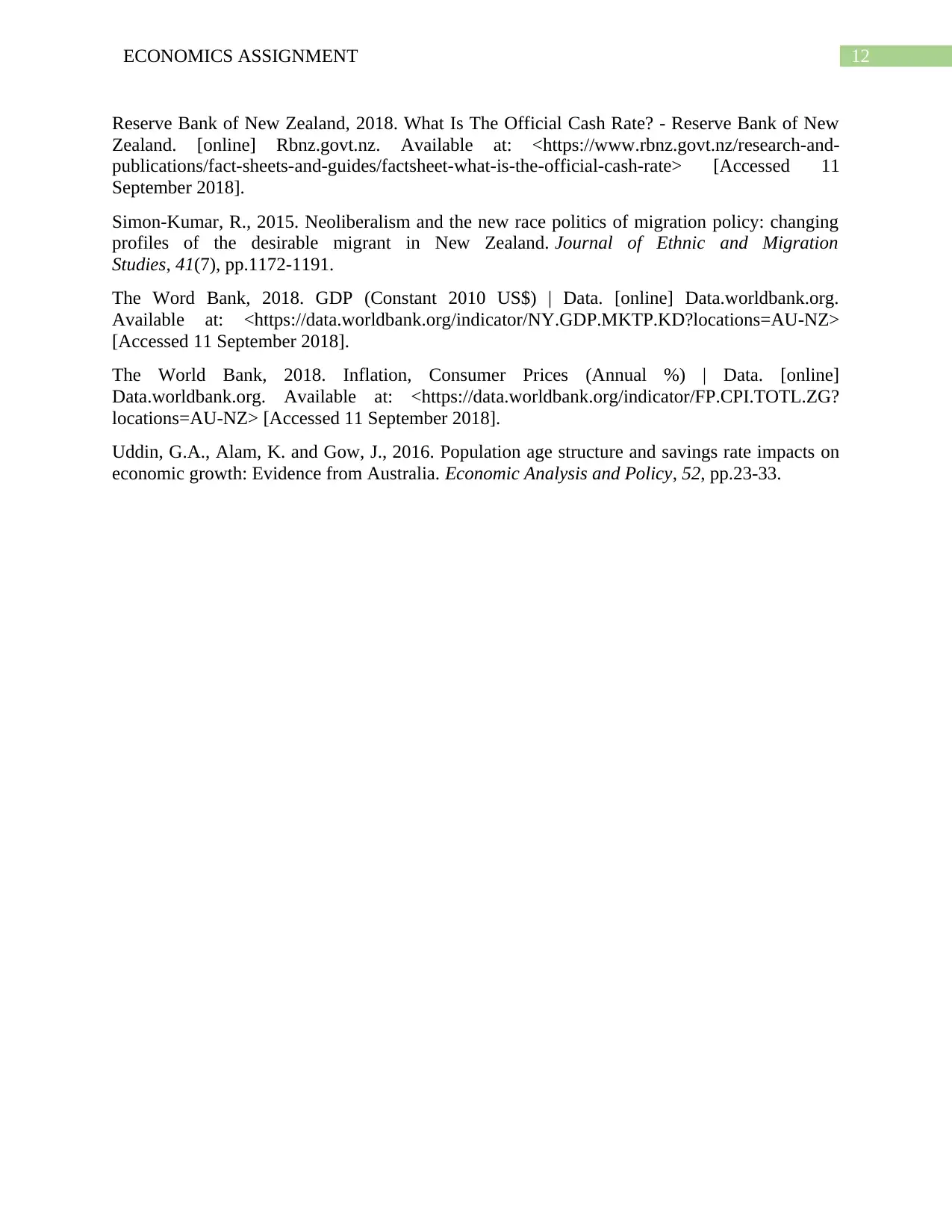
12ECONOMICS ASSIGNMENT
Reserve Bank of New Zealand, 2018. What Is The Official Cash Rate? - Reserve Bank of New
Zealand. [online] Rbnz.govt.nz. Available at: <https://www.rbnz.govt.nz/research-and-
publications/fact-sheets-and-guides/factsheet-what-is-the-official-cash-rate> [Accessed 11
September 2018].
Simon-Kumar, R., 2015. Neoliberalism and the new race politics of migration policy: changing
profiles of the desirable migrant in New Zealand. Journal of Ethnic and Migration
Studies, 41(7), pp.1172-1191.
The Word Bank, 2018. GDP (Constant 2010 US$) | Data. [online] Data.worldbank.org.
Available at: <https://data.worldbank.org/indicator/NY.GDP.MKTP.KD?locations=AU-NZ>
[Accessed 11 September 2018].
The World Bank, 2018. Inflation, Consumer Prices (Annual %) | Data. [online]
Data.worldbank.org. Available at: <https://data.worldbank.org/indicator/FP.CPI.TOTL.ZG?
locations=AU-NZ> [Accessed 11 September 2018].
Uddin, G.A., Alam, K. and Gow, J., 2016. Population age structure and savings rate impacts on
economic growth: Evidence from Australia. Economic Analysis and Policy, 52, pp.23-33.
Reserve Bank of New Zealand, 2018. What Is The Official Cash Rate? - Reserve Bank of New
Zealand. [online] Rbnz.govt.nz. Available at: <https://www.rbnz.govt.nz/research-and-
publications/fact-sheets-and-guides/factsheet-what-is-the-official-cash-rate> [Accessed 11
September 2018].
Simon-Kumar, R., 2015. Neoliberalism and the new race politics of migration policy: changing
profiles of the desirable migrant in New Zealand. Journal of Ethnic and Migration
Studies, 41(7), pp.1172-1191.
The Word Bank, 2018. GDP (Constant 2010 US$) | Data. [online] Data.worldbank.org.
Available at: <https://data.worldbank.org/indicator/NY.GDP.MKTP.KD?locations=AU-NZ>
[Accessed 11 September 2018].
The World Bank, 2018. Inflation, Consumer Prices (Annual %) | Data. [online]
Data.worldbank.org. Available at: <https://data.worldbank.org/indicator/FP.CPI.TOTL.ZG?
locations=AU-NZ> [Accessed 11 September 2018].
Uddin, G.A., Alam, K. and Gow, J., 2016. Population age structure and savings rate impacts on
economic growth: Evidence from Australia. Economic Analysis and Policy, 52, pp.23-33.
1 out of 13
Related Documents
Your All-in-One AI-Powered Toolkit for Academic Success.
+13062052269
info@desklib.com
Available 24*7 on WhatsApp / Email
![[object Object]](/_next/static/media/star-bottom.7253800d.svg)
Unlock your academic potential
© 2024 | Zucol Services PVT LTD | All rights reserved.





